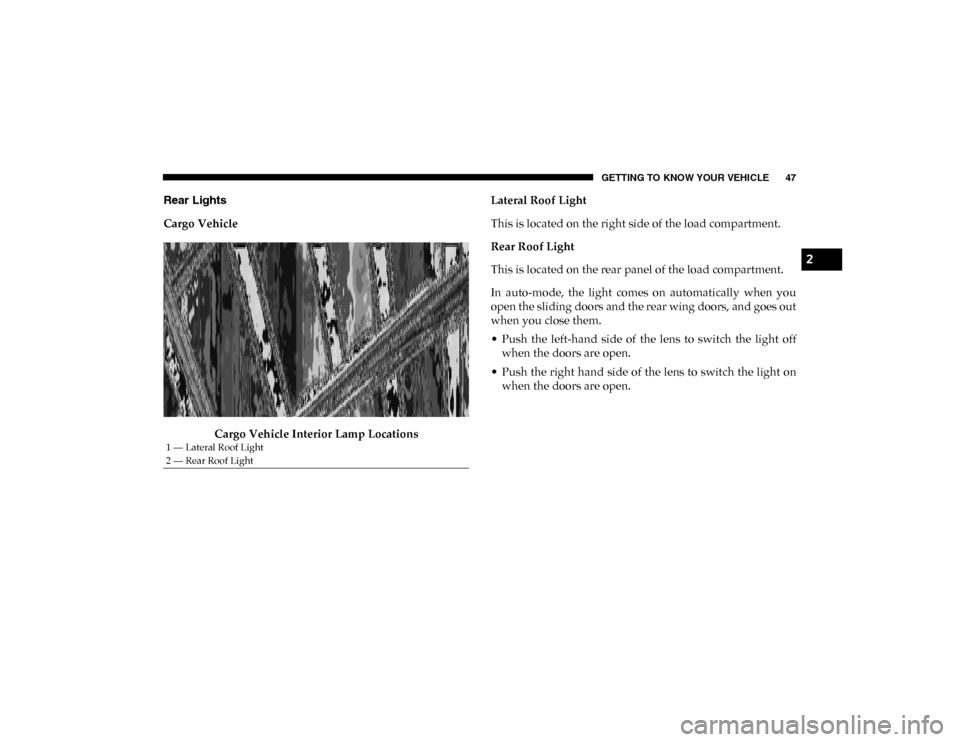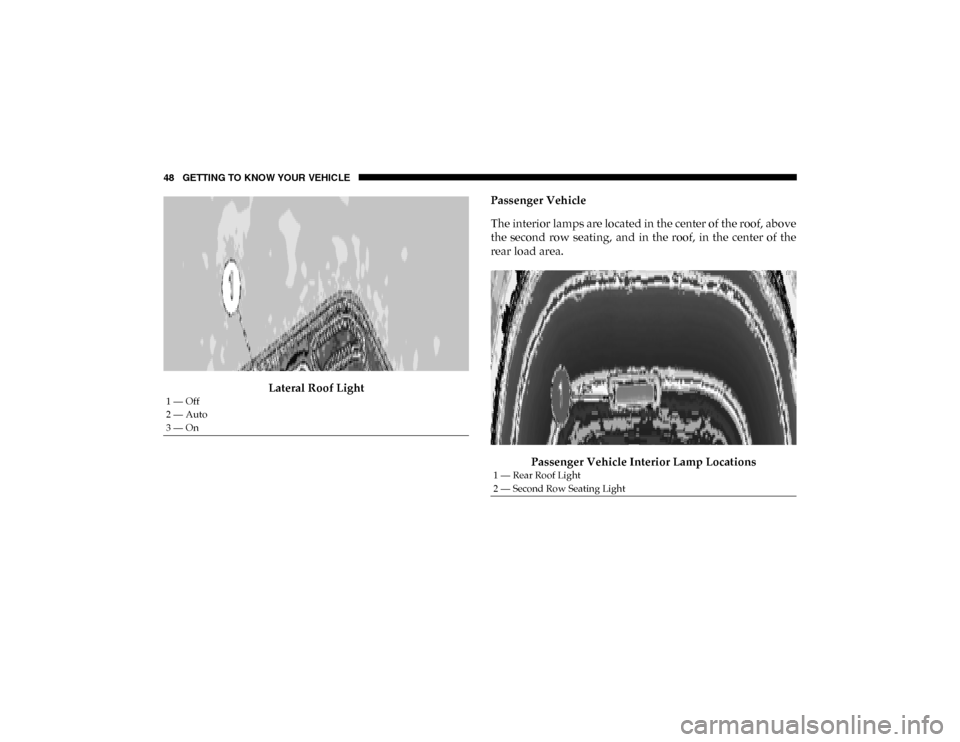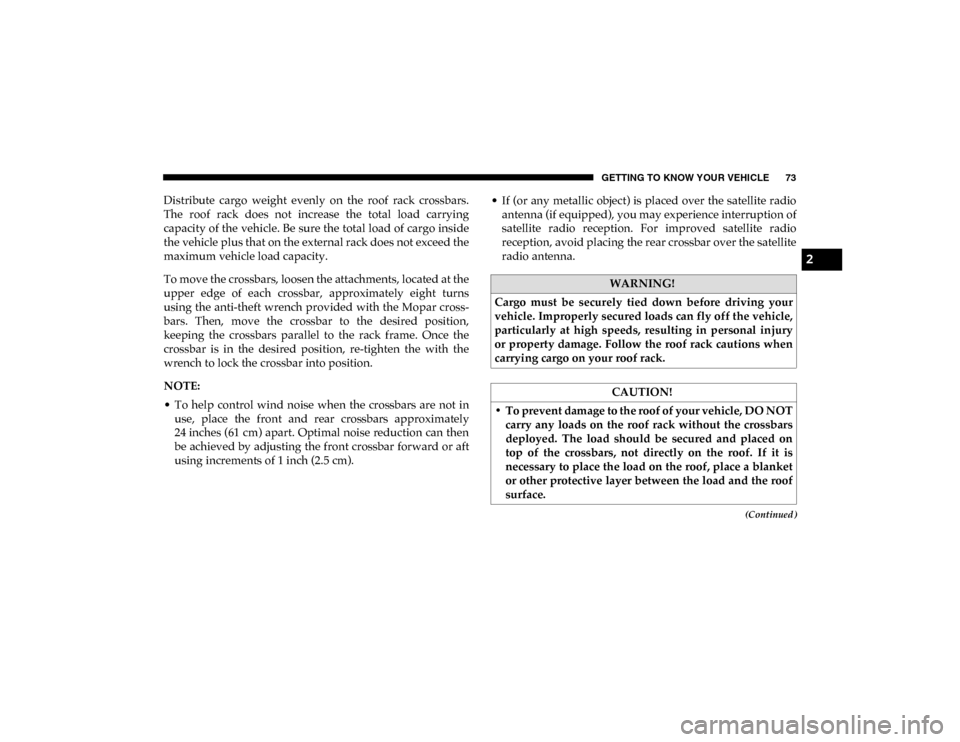2020 Ram ProMaster City roof
[x] Cancel search: roofPage 2 of 350

INSTALLATION OF RADIO TRANSMITTING
EQUIPMENT
Special design considerations are incorporated into this
vehicle’s electronic system to provide immunity to radio
frequency signals. Mobile two-way radios and telephone
equipment must be installed properly by trained person-
nel. The following must be observed during installation.
The positive power connection should be made
directly to the battery and fused as close to the battery as
possible. The negative power connection should be made
to body sheet metal adjacent to the negative battery
connection. This connection should not be fused.
Antennas for two-way radios should be mounted on
the roof or the rear area of the vehicle. Care should be
used in mounting antennas with magnet bases. Magnets
may affect the accuracy or operation of the compass on
vehicles so equipped.
The antenna cable should be as short as practical and
routed away from the vehicle wiring when possible. Use
only fully shielded coaxial cable.
Carefully match the antenna and cable to the radio to
ensure a low Standing Wave Ratio (SWR). Mobile radio equipment with output power greater than
normal may require special precautions.
All installations should be checked for possible
interference between the communications equipment
and the vehicle’s electronic systems.
Operating, servicing and maintaining a
passenger vehicle or off-highway motor
vehicle can expose you to chemicals inclu -
ding engine exhaust, carbon monoxide,
phthalates, and lead, which are known to
the State of California to cause cancer and
birth defects or other reproductive harm.
To minimize exposure, avoid breathing
exhaust, do not idle the engine except as ne -
cessary, service your vehicle in a well-ven -
tilated area and wear gloves or wash
your hands frequently when servicing
your vehicle. For more information go to
www.P65Warnings.ca.gov/passenger-vehicle.
WARNING:
VEHICLES SOLD IN CANADA
With respect to any vehicles sold in Canada, the name
FCA US LLC shall be deemed to be deleted and the
name FCA Canada Inc. used in substitution therefore.
DRIVING AND ALCOHOL
Drunken driving is one of the most frequent causes of
accidents.
Your driving ability can be seriously impaired with
blood alcohol levels far below the legal minimum. If
you are drinking, don’t drive. Ride with a designated
non-drinking driver, call a cab, a friend, or use public
transportation. This manual illustrates and describes the operation
of features and equipment that are either standard or
optional on this vehicle. This manual may also include
a description of features and equipment that are no
longer available or were not ordered on this vehicle.
Please disregard any features and equipment described
in this manual that are not on this vehicle.
FCA US LLC reserves the right to make changes in
design and specifications, and/or make additions to
or improvements to its products without imposing
any obligation upon itself to install them on products
previously manufactured.
Driving after drinking can lead to an accident.
Your perceptions are less sharp, your reflexes are
slower, and your judgment is impaired when you
have been drinking. Never drink and then drive.
WARNING!
Copyright © 2019 FCA US LLC
Page 3 of 350

INSTALLATION OF RADIO TRANSMITTING
EQUIPMENT
Special design considerations are incorporated into this
vehicle’s electronic system to provide immunity to radio
frequency signals. Mobile two-way radios and telephone
equipment must be installed properly by trained person-
nel. The following must be observed during installation.
The positive power connection should be made
directly to the battery and fused as close to the battery as
possible. The negative power connection should be made
to body sheet metal adjacent to the negative battery
connection. This connection should not be fused.
Antennas for two-way radios should be mounted on
the roof or the rear area of the vehicle. Care should be
used in mounting antennas with magnet bases. Magnets
may affect the accuracy or operation of the compass on
vehicles so equipped.
The antenna cable should be as short as practical and
routed away from the vehicle wiring when possible. Use
only fully shielded coaxial cable.
Carefully match the antenna and cable to the radio to
ensure a low Standing Wave Ratio (SWR). Mobile radio equipment with output power greater than
normal may require special precautions.
All installations should be checked for possible
interference between the communications equipment
and the vehicle’s electronic systems.
Operating, servicing and maintaining a
passenger vehicle or off-highway motor
vehicle can expose you to chemicals inclu -
ding engine exhaust, carbon monoxide,
phthalates, and lead, which are known to
the State of California to cause cancer and
birth defects or other reproductive harm.
To minimize exposure, avoid breathing
exhaust, do not idle the engine except as ne -
cessary, service your vehicle in a well-ven -
tilated area and wear gloves or wash
your hands frequently when servicing
your vehicle. For more information go to
www.P65Warnings.ca.gov/passenger-vehicle.
WARNING:
VEHICLES SOLD IN CANADA
With respect to any vehicles sold in Canada, the name
FCA US LLC shall be deemed to be deleted and the
name FCA Canada Inc. used in substitution therefore.
DRIVING AND ALCOHOL
Drunken driving is one of the most frequent causes of
accidents.
Your driving ability can be seriously impaired with
blood alcohol levels far below the legal minimum. If
you are drinking, don’t drive. Ride with a designated
non-drinking driver, call a cab, a friend, or use public
transportation. This manual illustrates and describes the operation
of features and equipment that are either standard or
optional on this vehicle. This manual may also include
a description of features and equipment that are no
longer available or were not ordered on this vehicle.
Please disregard any features and equipment described
in this manual that are not on this vehicle.
FCA US LLC reserves the right to make changes in
design and specifications, and/or make additions to
or improvements to its products without imposing
any obligation upon itself to install them on products
previously manufactured.
Driving after drinking can lead to an accident.
Your perceptions are less sharp, your reflexes are
slower, and your judgment is impaired when you
have been drinking. Never drink and then drive.
WARNING!
Copyright © 2019 FCA US LLC
Page 6 of 350

3
EXTERIOR LIGHTS .......................................................... 43
Multifunction Lever ...................................................... 43
Headlights ..................................................................... 43
Daytime Running Lights — If Equipped .................. 43
High Beams .................................................................... 44
Flash-To-Pass ................................................................ 44
Parking Lights ............................................................... 44
Follow Me Home/Headlight Delay ........................... 44
Fog Lights — If Equipped ........................................... 45
Turn Signals.................................................................... 45
Lane Change Assist ....................................................... 45
INTERIOR LIGHTS ............................................................ 46
Courtesy/Interior Lights .............................................. 46
WIPERS AND WASHERS .............................................. 50
Front Wiper Operation ................................................. 50
Rear Wiper Operation — If Equipped........................ 52
CLIMATE CONTROLS ..................................................... 53
Manual Climate Control Overview ............................ 53
Climate Control Functions ........................................... 56
Operating Tips ............................................................... 57
WINDOWS .......................................................................... 60
Power Windows — If Equipped ................................ 60
Window Bar Grates — If Equipped ............................ 63
Wind Buffeting .............................................................. 63
HOOD ...................................................................................64
Opening...........................................................................64
Closing.............................................................................65
CARGO AREA FEATURES ............................................66
Rear Cargo Tie-Downs ................................................66
INTERNAL EQUIPMENT .................................................68
Storage .............................................................................68
Cupholders ....................................................................69
Power Outlets ................................................................70
ROOF RACK — IF EQUIPPED .........................................72
GETTING TO KNOW YOUR INSTRUMENT
PANEL
INSTRUMENT CLUSTER ..................................................75
Instrument Cluster Descriptions .................................76
INSTRUMENT CLUSTER DISPLAY ...............................77
Location And Controls..................................................77
Change Engine Oil — If Equipped ...........................80
Instrument Cluster Display Menu Items....................80
TRIP COMPUTER ...............................................................82
Trip Button......................................................................82
Trip Functions ...............................................................83
Values Displayed ...........................................................83
2020_RAM_PROMASTER_CITY_OM_USA=GUID-7B6A7FCA-79B0-423F-95C5-ED2A949C3D13=1=en=.book Page 3
Page 50 of 350

GETTING TO KNOW YOUR VEHICLE 47
Rear Lights
Cargo VehicleCargo Vehicle Interior Lamp Locations Lateral Roof Light
This is located on the right side of the load compartment.
Rear Roof Light
This is located on the rear panel of the load compartment.
In auto-mode, the light comes on automatically when you
open the sliding doors and the rear wing doors, and goes out
when you close them.
• Push the left-hand side of the lens to switch the light off
when the doors are open.
• Push the right hand side of the lens to switch the light on when the doors are open.
1 — Lateral Roof Light
2 — Rear Roof Light
2
2020_RAM_PROMASTER_CITY_OM_USA=GUID-7B6A7FCA-79B0-423F-95C5-ED2A949C3D13=1=en=.book Page 47
Page 51 of 350

48 GETTING TO KNOW YOUR VEHICLE
Lateral Roof LightPassenger Vehicle
The interior lamps are located in the center of the roof, above
the second row seating, and in the roof, in the center of the
rear load area.
Passenger Vehicle Interior Lamp Locations
1 — Off
2 — Auto
3 — On
1 — Rear Roof Light
2 — Second Row Seating Light
2020_RAM_PROMASTER_CITY_OM_USA=GUID-7B6A7FCA-79B0-423F-95C5-ED2A949C3D13=1=en=.book Page 48
Page 52 of 350

GETTING TO KNOW YOUR VEHICLE 49
Second Row Seating And Rear Roof Lights Operation
In auto-mode, the light comes on automatically when you
open the sliding doors and the rear wing doors, and goes out
when you close them.
• Push the left-hand side of the lens to switch the light offwhen the doors are open.
• Push the right-hand side of the lens to switch the light on when the doors are open.
Interior Light
1 — Off
2 — Auto
3 — On
2
2020_RAM_PROMASTER_CITY_OM_USA=GUID-7B6A7FCA-79B0-423F-95C5-ED2A949C3D13=1=en=.book Page 49
Page 75 of 350

72 GETTING TO KNOW YOUR VEHICLE
(Continued)
ROOF RACK — IF EQUIPPED
The crossbars and siderails are designed to carry the weight
on vehicles equipped with a luggage rack. The load must not
exceed 150 lbs (68 kg), and should be uniformly distributed
over the luggage rack crossbars.
NOTE:
If not equipped with crossbars, an authorized dealer can
order and install Mopar crossbars built specifically for this
roof rack system.
WARNING!
To avoid serious injury or death:
• Only devices designed for use in this type of outlet should be inserted into any 12 Volt outlet.
• Do not touch with wet hands.
• Close the lid when not in use and while driving the vehicle.
• If this outlet is mishandled, it may cause an electric shock and failure.
CAUTION!
• Many accessories that can be plugged in draw power from the vehicle's battery, even when not in use (i.e.,
cellular phones, etc.). Eventually, if plugged in long
enough, the vehicle's battery will discharge sufficiently
to degrade battery life and/or prevent the engine from
starting.
• Accessories that draw higher power (i.e., coolers,vacuum cleaners, lights, etc.) will degrade the battery
even more quickly. Only use these intermittently and
with greater caution.
• After the use of high power draw accessories, or long periods of the vehicle not being started (with accesso -
ries still plugged in), the vehicle must be driven a suffi -
cient length of time to allow the generator to recharge
the vehicle's battery. CAUTION!
(Continued)
2020_RAM_PROMASTER_CITY_OM_USA=GUID-7B6A7FCA-79B0-423F-95C5-ED2A949C3D13=1=en=.book Page 72
Page 76 of 350

GETTING TO KNOW YOUR VEHICLE 73
(Continued)
Distribute cargo weight evenly on the roof rack crossbars.
The roof rack does not increase the total load carrying
capacity of the vehicle. Be sure the total load of cargo inside
the vehicle plus that on the external rack does not exceed the
maximum vehicle load capacity.
To move the crossbars, loosen the attachments, located at the
upper edge of each crossbar, approximately eight turns
using the anti-theft wrench provided with the Mopar cross-
bars. Then, move the crossbar to the desired position,
keeping the crossbars parallel to the rack frame. Once the
crossbar is in the desired position, re-tighten the with the
wrench to lock the crossbar into position.
NOTE:
• To help control wind noise when the crossbars are not in use, place the front and rear crossbars approximately
24 inches (61 cm) apart. Optimal noise reduction can then
be achieved by adjusting the front crossbar forward or aft
using increments of 1 inch (2.5 cm). • If (or any metallic object) is placed over the satellite radio
antenna (if equipped), you may experience interruption of
satellite radio reception. For improved satellite radio
reception, avoid placing the rear crossbar over the satellite
radio antenna.
WARNING!
Cargo must be securely tied down before driving your
vehicle. Improperly secured loads can fly off the vehicle,
particularly at high speeds, resulting in personal injury
or property damage. Follow the roof rack cautions when
carrying cargo on your roof rack.
CAUTION!
• To prevent damage to the roof of your vehicle, DO NOT carry any loads on the roof rack without the crossbars
deployed. The load should be secured and placed on
top of the crossbars, not directly on the roof. If it is
necessary to place the load on the roof, place a blanket
or other protective layer between the load and the roof
surface.
2
2020_RAM_PROMASTER_CITY_OM_USA=GUID-7B6A7FCA-79B0-423F-95C5-ED2A949C3D13=1=en=.book Page 73